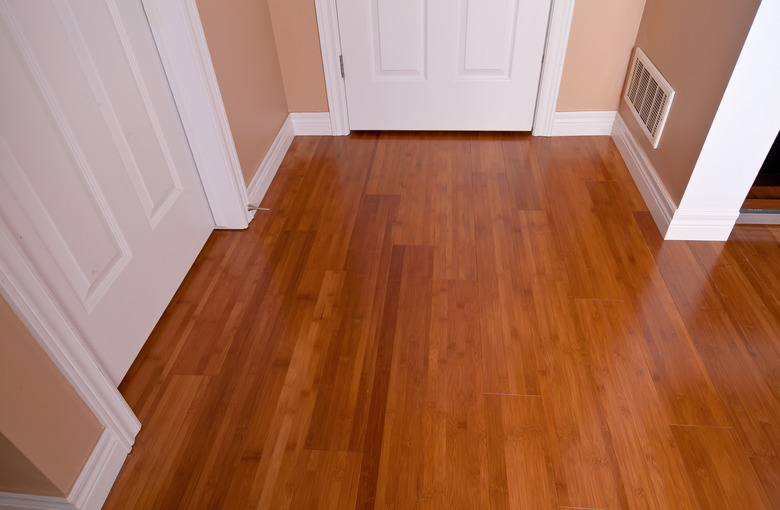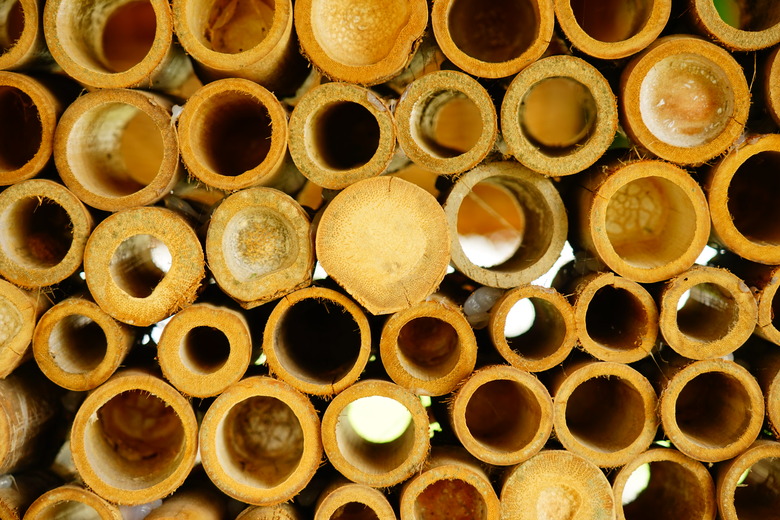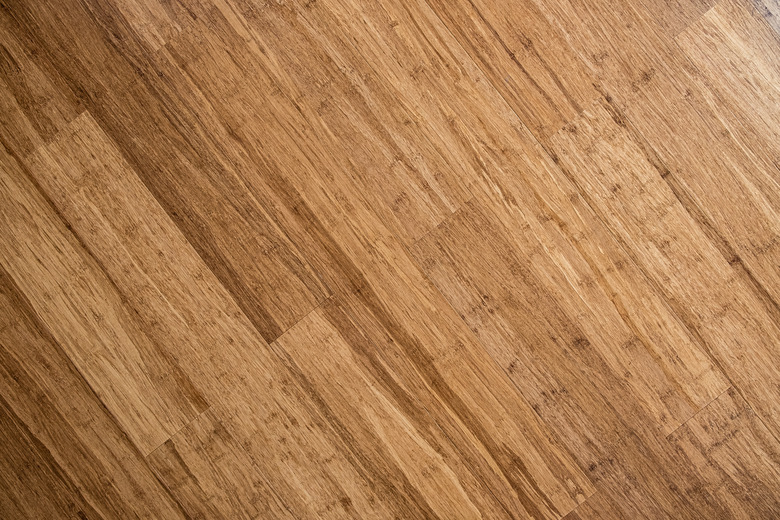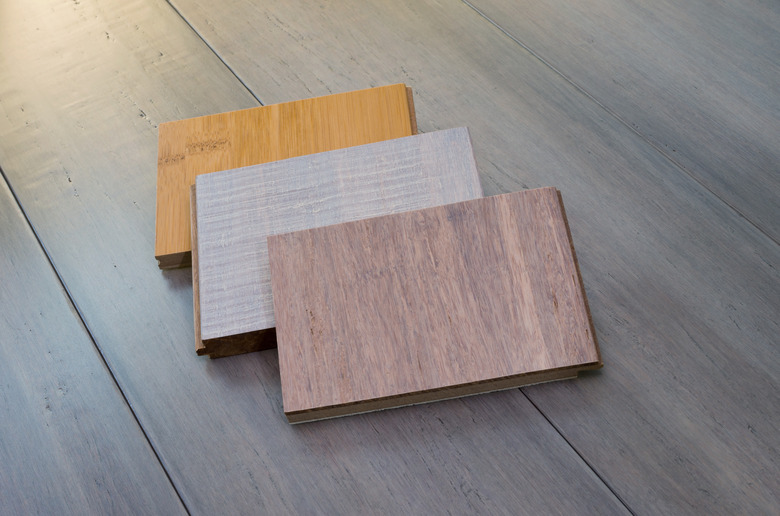Solid Bamboo Flooring: Pros And Cons
What do trees and grasses such as bamboo have in common? They are both living things, and they grow all over the world, but the most important thing to know if you're looking for solid bamboo flooring is that grass and wood are composed of basically the same material. Even though solid bamboo flooring's manufacturing is a somewhat more complex process than hardwood flooring, the finished products derive their strength and functionality from the polysaccharide known as cellulose that forms the outer coating of their cell walls.
The cellulose of most grasses has a significantly lower concentration of rigidity-bestowing lignin than wood, but large bamboo species, such as Moso bamboo, have much more lignin in their fibers, which is why people in countries where such species are abundant use bamboo as a building material. Flooring manufacturers increase the strength of bamboo fibers by pressing them together with a resin, and the finished product is not only attractive but it can rival and even surpass hardwood in durability. The bottom line, however, is because of their microscopic similarities, solid bamboo flooring has many of the same weaknesses as solid wood flooring.
How Bamboo Flooring Is Manufactured
How Bamboo Flooring Is Manufactured
Manufacturers make traditional hardwood flooring by cutting a tree, letting the wood dry and milling it into planks, but that won't work for bamboo, and one good reason is that the stalks are cylindrical, and flooring needs to be flat. In the dawning days of bamboo flooring, which weren't that long ago, manufacturers sliced the stalks into strips and glued the strips together, but much of the bamboo flooring you find in stores today is manufactured by a different process known as strand weaving.
- Horizontal and vertical bamboo: The original production process for solid bamboo flooring involved cutting the stalks into thin strips and gluing the strips together under pressure to form large planks that could be milled into floorboards. Vertical bamboo flooring is the result of milling along the grain, while milling across the grain produces horizontal bamboo. In both types, the strands and nodes of the stalk are clearly visible, giving the planks a characteristic grain instantly recognizable as bamboo.
- Carbonized bamboo: Similar to horizontal and vertical bamboo, carbonized bamboo is heated under pressure to turn it a darker color. The process softens the fibers, so carbonized flooring isn't as hard as the noncarbonized variety.
- Strand-woven bamboo: About 10 years after Smith & Fong of San Francisco first began producing bamboo flooring in Taiwan and China, the company pioneered the process of strand weaving. The stalks are softened by boiling and then are separated into individual fibers, which are then dipped in resin and pressed together to form the raw material for milling. The resultant flooring is orders of magnitude harder than horizontal and vertical bamboo, but it lacks the characteristic grain pattern, appearing more like a grainy hardwood than bamboo.
How Hard Is Solid Bamboo Flooring?
How Hard Is Solid Bamboo Flooring?
The lumber industry measures the hardness of a wood species by using the Janka test, which involves compressing a 1/2-inch steel ball halfway into a specimen and measuring the force required to do so. Species are arranged on a scale known as the Janka scale, with the hardest ones at the top and the softest at the bottom.
Red oak, considered the benchmark for solid hardwood flooring, has a Janka rating of between 1,260 and 1,290 pounds depending on which chart you consult. Maple, one of the hardest domestic hardwoods, has a rating of 1,450. Carbonized bamboo scores between 1,000 and 1,100, while vertical and horizontal bamboo score 1,762, which approaches the hardness of exotic hardwoods such as purple heart and Santos mahogany. However, that's nothing compared to strand bamboo.
Brazilian walnut, also known as ipé or lapacho, has a Janka rating of 3,680, making it the hardest commercially available hardwood, and anyone who has tried to cut or nail this wood knows how hard it is, but that's still nothing. Bamboo Flooring Facts lists the hardness of strand bamboo as 4,600, which is a number you won't even see on most Janka charts. That's so hard that it almost deserves to be measured on the Mohs scale used for comparing the hardness of metals and minerals.
It's Hard, But Is It Durable?
It's Hard, But Is It Durable?
Remember that bamboo, like wood, is composed of individual cells with cellulose walls, and while cellulose is rigid, it isn't waterproof. Like wood, the bamboo cells will soak up moisture when the humidity is high and release it when the humidity falls. That makes solid bamboo flooring a less-than-ideal choice for a moist subfloor, such as one that is below grade or above an unventilated crawl space.
In an effort to mitigate the effects of moisture vulnerability, flooring manufacturers coat solid bamboo flooring with several coats of rock-hard finish. Cali Bamboo claims to protect its strand bamboo Fossilized Flooring with 10 coats of finish, upping its Janka hardness to a whopping 5,547 pounds. This still doesn't make the flooring waterproof, but it does make it more water-resistant and, importantly, scratch-resistant.
It's rare to find unfinished bamboo flooring, but even if you do, you're better off with a prefinished product. Factory finishes are often catalyzed, and they can be baked on, making them harder than any finish you can apply on-site.
Comparing Engineered to Solid Bamboo Flooring
Comparing Engineered to Solid Bamboo Flooring
The increasing demand for hardwood flooring coupled with dwindling forest resources led to the development of engineered flooring, which consists of a hardwood veneer covering a plywood core. Far from being a cheap knock-off, engineered hardwood is in many ways superior to solid hardwood, and the same is true for engineered bamboo flooring.
Engineered types of flooring can be milled into click-lock planks that form a floating floor, or they can be nail-down. Regardless of the installation method, the planks resist warping because they are constructed in perpendicular layers, and you can get them in wide-plank formats and install them in moist locations in which solid bamboo planks would likely warp, especially if you include a waterproofing underlayment. Moreover, because the surface is the same durable bamboo, and it has the same durable finish, it has the same scratch resistance as solid bamboo flooring.
The main drawback of engineered bamboo flooring is that it has a veneer, so you can only refinish it once or twice depending on the veneer thickness. Plus, when choosing engineered bamboo, you only have prefinished options. You'll probably never want to sand off the finish, but you'll have to if you want to change the color of the floor. If you anticipate this possibility, choose a product with a robust wear layer.
Some Pluses of Solid Bamboo Flooring
Some Pluses of Solid Bamboo Flooring
In your search for the right wood flooring for your remodeling project, you'll be comparing various species of hardwood with bamboo, and you'll also have to make a choice between engineered and solid bamboo. Some reasons you might want to choose solid bamboo include:
- It's eco-friendly: Bamboo plants grow quickly, and they regenerate themselves, so solid bamboo flooring is one of the most eco-friendly materials you can find. Because bamboo is typically harvested at five-year intervals on plantations, eliminating the need for cutting trees, solid bamboo is even more eco-friendly than engineered bamboo, which does require the use of forest products.
- You can refinish it multiple times: If you're going to invest in a new floor, you want it to last as long as possible. Whereas you can only refinish engineered bamboo once or twice, you can refinish solid bamboo multiple times. Bamboo stains well, so that means you can change the color of your floor more than once to match design updates.
- It's inexpensive: You can find solid bamboo planks for around $3 per square foot, according to 2018 data from Floor Critics. That's a little more expensive than engineered bamboo, which costs between $2 and $4 per square foot, but it's less than you'd pay for oak or maple.
- It's termite-proof: The bugs that love to eat your house won't be attracted to your solid bamboo flooring, and if they are, they'll die. The chemicals used to treat the bamboo will kill them. You can't say this about hardwood or even engineered bamboo.
The Minuses of Solid Bamboo Flooring
The Minuses of Solid Bamboo Flooring
There wouldn't be any competition in the flooring market if you could find a product that is indestructible yet comfortable and looks great in every circumstance. Solid bamboo flooring has a wide appeal, but the look of natural bamboo doesn't appeal to everyone, and products with a modified or wire-brushed finish can look artificial. Besides this, a few more reasons you might bypass solid bamboo in your hunt for new flooring include:
- It scratches: Unless you purchase a super high-quality product, scratches are almost inevitable, if not from foot traffic then from pet claws and furniture legs. Vertical and horizontal bamboo isn't as hard as the strand-woven variety, and you may find that the floor needs refinishing sooner than you had hoped.
- It doesn't like moisture: If moisture seeps through the subfloor or the room humidity varies from very high to very low, the planks will probably curl. This is especially likely if you install wide-plank flooring, whether it's horizontal, vertical or strand-woven bamboo flooring.
- It can off-gas: In the early days of solid bamboo flooring, it was notorious for the presence of formaldehyde in its binding adhesive, and many less-expensive horizontal and vertical planks still contain formaldehyde. If you're sensitive to VOCs (volatile organic compounds), but you love bamboo, your best bet is to limit your search to high-quality products and be sure to check the manufacturer's specifications for the materials used in the manufacturing process.
- It isn't a traditional hardwood: Appearance is at the top of the list of requirements for many homeowners, and bamboo has a characteristic contemporary look that may not fit in a cozy den with a fireplace and lush furniture.
Installing Bamboo Flooring
Installing Bamboo Flooring
Unlike engineered bamboo, which comes in a variety of formats, solid bamboo comes in only one – tongue and groove – and it has to be nailed or glued to the subfloor. This makes a permanent floor that won't lift or move, which is the best kind of floor in a home with a wheelchair. The permanence and stability of nail-down flooring is also a plus when the time comes to sell your home.
On the other hand, nail-down flooring is not the most DIY-friendly material to install, and you'll probably have to hire a pro, which drives up the cost of the new floor. Expect to pay between $4 and $7 per square foot for installation, which together with the materials cost for high-quality flooring could leave you with a bill in the neighborhood of $2,000 for a standard rectangular 10- by 12-foot room. Compare that to about $500 for a moderately priced engineered bamboo floor that you install yourself in the same space.



